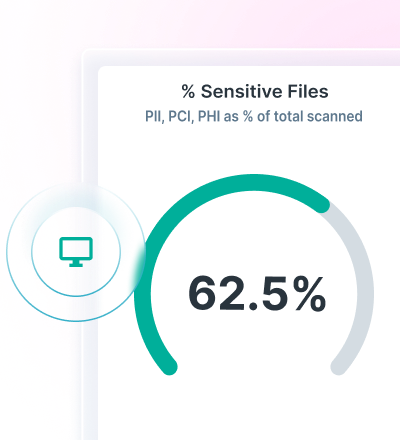Best Data Security Software for Businesses in 2025
0 minuti di lettura

Lionel Menchaca
Security leaders face a new wave of data sprawl that’s moving faster than traditional controls can handle.
Sensitive data now flows through SaaS apps, GenAI prompts, cloud storage and third-party systems, usually without visibility or consistent policy enforcement. Modern data security software solutions work to close these gaps by showing where data lives, how it’s used and where it’s at risk so teams can protect it without slowing down the business.
And since the global average cost of a data breach exceeds $4.4 million according to IBM, data security is a growing concern for many organizations.
The rapid expansion of AI has only made visibility of data more critical. As AI tools reshape data security, sensitive content can easily surface in prompts or model training data if not properly governed.
This guide compares the top 10 data security platforms of 2025, outlines must-have capabilities and offers guidance to help you choose the right solution for your environment.
Top Data Security Solutions for Businesses in 2025
1. Forcepoint
Core capabilities: Unified DLP, DSPM, DDR and CASB with inline and API controls, classification and policy orchestration
Overview:
The Forcepoint Data Security Cloud provides unified protection across web, cloud, endpoint and private apps. Security teams can eliminate policy duplication and manage everything from a single console, reducing administrative overhead while strengthening control.
Top Features:
- Built-in Forcepoint Data Loss Prevention (DLP) enforcement
- Predefined policy library
- Classification and tagging via AI Mesh
- Inline and API inspection
- Shadow AI defense
- Analytics and reporting
Pros:
- On-prem/Hybrid/SaaS support
- Pre-built remediation workflows
- Broad SaaS, web and endpoint coverage
Cons:
- Consolidation may require workflow changes
- Coordination across IT and security teams needed for rollout
Ideal for:
- Enterprises wanting centralized visibility and control over data with hybrid deployment.
Customer feedback:
- Customers highlight consistent policy enforcement that reduces false positives and rule duplication.
2. Cyera
Core capabilities: DSPM, data discovery, lineage and exposure analysis
Overview:
Cyera offers rapid cloud data discovery and classification, showing where sensitive data resides, who can access it and how it’s used.
Top Features:
- Multi-cloud DSPM
- Automated data discovery
- Data lineage mapping
- Risk insights
Pros:
- Fast deployment and scanning
- Strong visibility across multi-cloud environments
Cons:
- No native DLP enforcement
- Requires integrations for endpoint and on-prem data
Ideal for:
- Cloud-first organizations seeking quick visibility and risk reduction
Customer feedback:
- Users value the clarity of Cyera’s data maps early in data security programs.
3. Varonis
Core capabilities: Permissions analysis, insider risk analytics and SaaS data store protection
Overview:
Varonis gives insight into permissions, entitlements and insider activity, helping reduce access sprawl and data misuse.
Top Features:
- SaaS and data store visibility
- Permissions and entitlement analysis
- Insider risk analytics
- Automated remediation
Pros:
- Deep visibility into access and entitlements
- Strong insider risk analytics
Cons:
- Limited native prevention
- Better for governance than real-time DLP
Ideal for:
- Companies addressing excessive access or insider threats across SaaS and file systems
Customer feedback:
- Appreciated for revealing who has access to what data—and why.
4. Netskope
Core capabilities: CASB, SWG, ZTNA and inline data protection
Overview:
Netskope provides real-time data protection through its Security Service Edge platform, integrating cloud visibility with inline enforcement.
Top Features:
- Inline SaaS and web DLP
- CASB, SWG and ZTNA
- Cloud threat protection
- User and activity analytics
Pros:
- Strong inline controls
- Integrated SSE stack
Cons:
- DSPM still maturing
- Add-ons may be required for full coverage
Ideal for:
- Teams seeking inline protection across SaaS, web, and private app access
Customer feedback:
- Praised for real-time enforcement and SaaS visibility depth.
5. Palo Alto Networks
Core capabilities: Prisma Access for CASB and SWG, cloud app security and threat protection
Overview:
Palo Alto Networks delivers consistent data and threat protection through its Prisma platform, ideal for organizations already invested in its stack.
Top Features:
- Prisma Access platform
- CASB and SWG
- Cloud app monitoring
- Threat and data protection
Pros:
- Broad ecosystem coverage
- Tight integration with Palo Alto tools
Cons:
- Can be complex for smaller teams
- DSPM less advanced than specialists
Ideal for:
- Enterprises consolidating multiple security functions into one platform
Customer feedback:
- Users report simpler management and better security outcomes after consolidation.
6. Microsoft Purview
Core capabilities: Classification, labeling, insider risk management and information governance
Overview:
Microsoft Purview centralizes governance and compliance across Microsoft 365, with native integration for classification and insider threat controls.
Top Features:
- Data classification and labeling
- Insider risk management
- Information governance
- M365-native policy controls
Pros:
- Strong integration with Microsoft 365
- Unified governance and compliance capabilities
Cons:
- Limited visibility beyond Microsoft ecosystem
- Requires manual effort for multi-cloud coverage
Ideal for:
- Microsoft environments wanting built-in data governance and risk management
Customer feedback:
- Praised for seamless M365 integration but less flexible across non-Microsoft apps.
7. Proofpoint
Core capabilities: Email DLP, threat intelligence and insider risk monitoring
Overview:
Proofpoint targets human-driven data risk by combining email DLP, insider threat management, and behavioral analytics.
Top Features:
- Email DLP and filtering
- Insider threat management
- Threat intelligence
- User risk insights
Pros:
- Strong email protection
- Advanced user behavior analytics
Cons:
- Limited coverage beyond email channels
- Broader DLP requires integrations
Ideal for:
- Companies managing insider or email-driven data exposure
Customer feedback:
- Praised for precise, behavior-based detection.
8. Symantec
Core capabilities: Enterprise DLP across endpoint, network and cloud
Overview:
Symantec offers mature DLP capabilities built for large, regulated organizations.
Top Features:
- Enterprise DLP
- Endpoint and network enforcement
- Cloud coverage
- Mature data classifiers
Pros:
- Proven enterprise-grade DLP
- Deep data classifiers for compliance
Cons:
- Legacy complexity
- Modernization still in progress
Ideal for:
- Enterprises expanding long-standing DLP programs
Customer feedback:
- Customers value consistent policies and strong rule sets built over years.
9. Zscaler
Core capabilities: CASB, SWG and threat prevention
Overview:
Zscaler enforces inline policies at high speed, offering visibility into cloud app usage and data movement to the internet.
Top Features:
- Inline controls
- Cloud app discovery
- Threat and data protection
Pros:
- Strong performance and reliability
- Inline enforcement across users and locations
Cons:
- Limited DSPM visibility
- Requires integrations for full context
Ideal for:
- Organizations needing fast global protection without latency trade-offs
Customer feedback:
- Praised for speed and policy reliability.
10. Trellix (McAfee)
Core capabilities: Endpoint DLP, analytics, and policy enforcement
Overview:
Trellix, formerly McAfee Enterprise, continues to deliver strong endpoint DLP with analytics for insider and device risk.
Top Features:
- Endpoint DLP
- Analytics and reporting
- Threat correlation
- Policy enforcement
Pros:
- Deep endpoint visibility
- Familiar workflows for legacy users
Cons:
- Limited cloud coverage
- Integrations still evolving
Ideal for:
- Enterprises upgrading from traditional endpoint DLP
Customer feedback:
- Users value endpoint strength but want broader cloud integration.
What Are the Must-Have Features of a Great Data Security Tool?
A great data security platform provides visibility and control over business data everywhere it lives or moves. The core capabilities to look for are:
- Consistent DLP policy enforcement
One set of policies that protect data across endpoints, cloud apps, web and email. - Accurate, automated data classification
Discovery and tagging of structured and unstructured sensitive data, improving accuracy through innovative AI technologies. - Inline and API-level SaaS visibility
Real-time monitoring of data in motion plus deep insight into how data is stored and shared inside of cloud applications. - Centralized analytics and reporting
A single view that correlates data movement, user activity and policy outcomes for faster investigation, fewer false-positive alerts and easier compliance.
These essentials ensure organizations maintain continuous visibility, adaptive enforcement and scalable protection across apps, devices and systems without slowing down the business.
How to Choose the Right Data Security Software
The right platform helps you simplify complexity, strengthen control and scale securely in an AI-driven world. Focus on these four priorities when evaluating your next data security investment:
Contain Data Sprawl and Fragmentation
- Data now lives everywhere—across SaaS, endpoints, and shadow IT. Look for a solution that unifies discovery and classification across your entire environment so policies apply consistently wherever data moves. Forcepoint provides full visibility across cloud, web and endpoint to keep fragmented data ecosystems under control.
Manage the AI Risk Explosion
- Generative AI tools create new data pathways and exposure points every day. Choose a platform that extends protection to AI-driven workflows and prevents sensitive data from leaking into prompts or training sets. Forcepoint AI Mesh improves classification accuracy that scales protection into every AI interaction.
Stay Ahead of Compliance Demands
- Regulatory pressure is rising across regions and industries. A modern data security platform should automate classification, tagging and reporting to demonstrate compliance without slowing innovation. Forcepoint helps you prove control with unified, audit-ready evidence for frameworks like GDPR, HIPAA, CCPA and many others.
Look for True Security Stack Integration
- Point products create visibility gaps and increase operational friction. The best data security software integrates with your data, cloud, and analytics tools to create shared intelligence across systems. Forcepoint’s unified platform connects DDR, DLP, DSPM and CASB capabilities to deliver real-time, adaptive protection from a single policy engine.
For additional best practices on scaling your program, see data security best practices.
Final Takeaway
When data discovery, classification, monitoring and enforcement work through one platform, risk is reduced and protection becomes easier to manage.
See how this all comes together in the Forcepoint Data Security Cloud.

Lionel Menchaca
Leggi più articoli di Lionel MenchacaAs the Content Marketing and Technical Writing Specialist, Lionel leads Forcepoint's blogging efforts. He's responsible for the company's global editorial strategy and is part of a core team responsible for content strategy and execution on behalf of the company.
Before Forcepoint, Lionel founded and ran Dell's blogging and social media efforts for seven years. He has a degree from the University of Texas at Austin in Archaeological Studies.
 Gartner®: Market Guide for Data Security Posture ManagementConsultare il Rapporto dell'Analista
Gartner®: Market Guide for Data Security Posture ManagementConsultare il Rapporto dell'Analista
X-Labs
Ricevi consigli, analisi e notizie direttamente nella tua casella di posta

Al Punto
Sicurezza Informatica
Un podcast che copre le ultime tendenze e argomenti nel mondo della sicurezza informatica
Ascolta Ora








